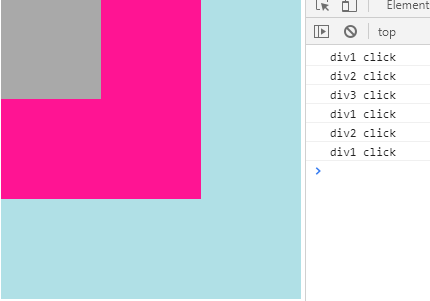
This time I will show you how to use JS event binding and event flow model. What are the precautions for using JS event binding and event flow model? The following is a practical case. Let’s take a look. .
1. JS events
(1) JS event classification
1. Mouse event :click/dbclick/mouseover/mouseout2.HTML event:onload/onunload/onsubmit/onresize/onchange/onfoucs/onscroll 3. Keyboard events: keydown: Triggered when the keyboard is pressed keypress: Triggered the moment the keyboard is pressed and lifted.
keyup: trigger when keyboard is raised
②keypress can only capture numbers, letters, and symbol keys, but not functions key.
③When long pressing, execute keydown--keypress in loop
④If there is keydown, there is not necessarily keyup. When the focus is lost when long pressing, keyup will no longer be triggered
⑤keypress is case-sensitive, keydown, kewup are not different.
document.onkeydown=function(e){
console.log(e);
}
document.onkeydown=function(){
console.log(window.event);
}//兼容浏览器的写法:
document.onkeydown=function(e){
e==e||Window.event;
var Code=e.keyCode||e.which||e.charCode;
if(code==13){
//回车
}
}5. How to determine the keyboard keys?
①In the re-starting function, receive the event factor e.② You can use e.key to directly go to the pressed key character (not recommended).
③You can use keyCode/which/charCode to get the ASCII code value of the key.
var Code=e.keyCode||e.which||e.charCode;
//判断组合键
var isAlt=0,isEnt=0;
document.onkeyup=function(e){
if(e.keyCode==18){
isAlt=1;
}
if(e.keyCode==13){
isEnt=1;
}
if(isAlt==1&&isEnt==1){
alert("同时按下Alt和Enter键");
}
}
document.onkeyup=function(){
console.log("keyup");
}
document.onkeypress=function(){
console.log("keypress");
}
document.onkeydown=function(){
console.log("keydown");
}
document.onkeypress=function(){
console.log(window.event);
}
//判断是否按下了回车键
document.onkeydown=function(e){
var code=e.keyCode;
if(code==13){
alert("你输入的是回车键");
}
}window.onload =function(){//Event}
//body内容 <body> <button onclick="func()">内联模型绑定</button> <button id="btn1">哈哈哈哈</button> <button id="btn2">DOM2模型绑定</button> <button id="btn3">取消DOM2</button> </body>
<button onclick="func()">内联模型绑定</button>
document.getElementById("btn1")=function(){} Disadvantages: The same type of event can only be added once to the same node. If added multiple times, the last one will take effect.
document.getElementById("btn1").onclick=function(){
alert(1234);
}
document.getElementById("btn1").onclick=function(){
alert(234);
}//重复的只能出现最近的一次document.getElementById("btn3").onclick=function(){//不能取消匿名函数
if(btn.detachEvent){
btn.detachEvent("onclick",func1);
}else{
btn.removeEventListener("click",func1);
}
alert("取消DOM2");
} ②After IE8, use .addEventListener("click", function, true/false);
Parameter three: false (default) means event bubbling, passing in true means event capture.
③ Compatible with all browser processing methods:
var btn=document.getElementById("btn1");
if(btn.attachEvent){
btn.attachEvent("onclick",func1);//事件,事件需要执行的函数IE8可以
}else{
btn.attachEventListener("click",func1);
} ②Events bound using DOM2 can be canceled with special functions.
3. Cancel event binding:
①Use attachEvent to bind and use detachevent to cancel.
②Use attachEventListener to bind and use removeEventListenter to cancel.
Note: If the event bound to DOM2 needs to be canceled, when binding the event,
the callback function must be a function name, and cannot be an anonymous function, because when the event is canceled, the callback function Enter the function name to cancel.
3. JS event flow model
(1) Event flow model in JS1. 事件冒泡(fasle/不写):当触发一个节点的事件是,会从当前节点开始,依次触发其祖先节点的同类型事件,直到DOM根节点。
2. 事件捕获(true):当初发一个节点的事件时,会从DOM根节点开始,依次触发其祖先节点的同类型事件,直到当前节点自身。
3. 什么时候事件冒泡?什么时候事件捕获?
① 当使用addEventListener绑定事件,第三个参数传为true时表示事件捕获;
② 除此之外的所有事件绑定均为事件冒泡。
4. 阻止事件冒泡:
① IE10之前,e.cancelBubble = true;
② IE10之后,e.stopPropagation();
5. 阻止默认事件:
① IE10之前:e.returnValue = false;
② IE10之后:e.preventDefault();
//css
#p1{
width: 300px;;
height: 300px;
background-color: powderblue;
}
#p2{
width: 200px;
height: 200px;
background-color: deeppink;
}
#p3{
width: 100px;
height: 100px;
background-color:#A9A9A9;
}
//html
<p id="p1">
<p id="p2">
<p id="p3"></p>
</p>
</p>
<a href="01-事件笔记.html" rel="external nofollow" onclick="func()">超链接</a>
p1.addEventListener("click",function(){
console.log("p1 click");
},false);
p2.addEventListener("click",function(){
console.log("p2 click");
},false);
p3.addEventListener("click",function(){ //原来的顺序是:3-->2-->1。
// myParagraphEventHandler(); //截获事件流后,只触发3.但是从2开始依然会冒泡;
console.log("p3 click");
},false);结果(事件冒泡)(由小到大p3-》p2-》p1):

p1.addEventListener("click",function(){
console.log("p1 click");
},true);
p2.addEventListener("click",function(){
console.log("p2 click");
},true);
p3.addEventListener("click",function(){
// myParagraphEventHandler(); //截获事件流后,只触发3.但是从2开始依然会冒泡;
console.log("p3 click");
},true);结果(事件捕获)(由小到大p3-》p2-》p1):

//依然遵循事件冒泡
document.onclick=function(){
console.log("document click")
}
//截获事件流阻止事件冒泡
function myParagraphEventHandler(e) {
e = e || window.event;
if (e.stopPropagation) {
e.stopPropagation(); //IE10以后
} else {
e.cancelBubble = true; //IE10之前
}
}
//截获事件流阻止事件冒泡
function myParagraphEventHandler(e) {
e = e || window.event;
if (e.stopPropagation) {
e.stopPropagation(); //IE10以后
} else {
e.cancelBubble = true; //IE10之前
}
}
//阻止默认事件
function eventHandler(e) {
e = e || window.event;
// 防止默认行为
if (e.preventDefault) {
e.preventDefault(); //IE10之后
} else {
e.returnValue = false; //IE10之前
}
}相信看了本文案例你已经掌握了方法,更多精彩请关注php中文网其它相关文章!
推荐阅读:
The above is the detailed content of How to use JS event binding and event flow model. For more information, please follow other related articles on the PHP Chinese website!




